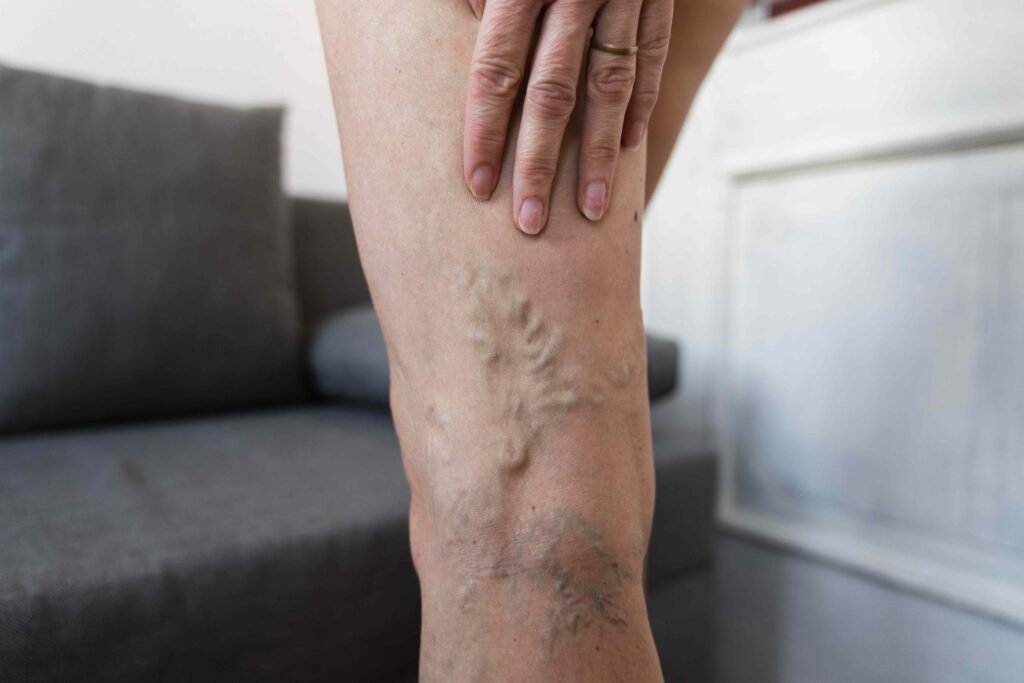Varicose veins—visible, swollen blood vessels underneath your skin, usually in your legs—can happen when blood that usually flows toward your heart backs up and pools in a vein. Varicose veins are not always something to worry about, but it’s important to treat them if you develop severe symptoms. They can be uncomfortable and lead to complications such as bleeding, open sores (ulcers), or blood clots.
Varicose veins may be a sign of a condition called chronic vein disease, or chronic venous insufficiency. This condition tends to get worse over time, but treatment can help relieve symptoms and slow its progression.
Some symptoms of varicose veins or chronic venous insufficiency can be uncomfortable, including:
- Aches or pain in your legs
- Muscle cramps in your legs, usually at night
- Feeling of fullness in your legs
- Itchy or burning skin near the swollen vein
- Swollen feet or ankles
Over time, your symptoms can get worse as varicose veins become more severe. You may develop symptoms that require medical attention, such as:
- More intense pain, especially after standing or sitting for long periods
- Leg swelling
- Skin changes like thickening, hardening, or scaliness
- Dry, irritated skin
- Skin ulcers
If not managed actively, chronic venous insufficiency may worsen over time. The pressure inside the affected veins may increase as the blood valves in your legs weaken. Blood can back up more and more, which can lead to serious health complications.
Complications of varicose veins can include:
- Skin ulcers that won’t heal, which can lead to infection
- Blood clots in the legs
- Trouble completing daily tasks, especially those that require standing for extended periods
- Permanent appearance changes
Research has also linked varicose veins to other vein conditions, including:
- Deep vein thrombosis (DVT): DVT refers to a blood clot in a vein deep inside your body. It can be life-threatening. Studies have shown that people with varicose veins may be up to five times more likely to develop DVT than those without varicose veins.
- Pulmonary embolism: A pulmonary embolism occurs when an artery in your lung is blocked, usually by a blood clot that has traveled from a deep vein. Some research suggests that people with varicose veins have higher rates of PE.
- Peripheral artery disease (PAD): PAD happens when arteries narrow and restrict blood flow to your arms and legs. Some research has linked varicose veins to higher rates of PAD.
However, the links between varicose veins and these conditions may be due to factors that increase the risk for both, such as smoking. More research is needed to fully understand the relationship.
If your symptoms are negatively affecting you, tell a doctor. They may perform an imaging test called a duplex ultrasound to look at your veins. Then, they can suggest appropriate treatment options.
Lifestyle Changes
Treatment for varicose veins commonly includes lifestyle changes that can ease symptoms, slow down progression, and prevent complications. Your doctor may recommend changes like these:
- Keep your legs moving: Try not to sit or stand for long periods. Take frequent breaks to move your legs and get your blood flowing.
- Wear compression socks or stockings: Compression socks help push blood out of your legs and back toward your heart. While they are effective, they can be uncomfortable for some people.
- Elevate your legs often: Raising your legs higher than your heart helps blood drain from your legs and back toward your heart. You can do this three or four times per day for up to 15 minutes each time.
- Get regular exercise and manage your weight: Gentle exercise, like walking or swimming, helps your muscles move blood back toward your heart. And regular exercise can help you lose weight if needed, lessening the pressure on the veins in your legs.
- Care for your skin: Moisturizing regularly and treating any sores that appear on your legs can help prevent infections.
- Don’t smoke: Smoking and other tobacco use damages your veins. You are more likely to develop new varicose veins if you smoke.
Surgical Procedures
If lifestyle changes aren’t enough to relieve your symptoms or keep varicose veins from getting worse, a doctor may suggest an in-office procedure. These are usually minimally invasive, outpatient procedures. They aim to block, destroy, or remove the swollen vein.
These treatment options for varicose veins include:
- Phlebectomy: For varicose veins in smaller blood vessels, your provider can remove the affected veins through small cuts in your skin.
- Endovenous ablation: Your provider uses a laser or radiofrequency to seal off the vein.
- Sclerotherapy: Your provider injects a chemical solution into the vein to harden and destroy it.
- Vein ligation and stripping: In more severe cases, your provider may tie off the vein (ligation) and then remove it (stripping).
As with all surgeries and procedures, these procedures have possible risks and side effects. Varicose veins may also come back after a procedure. Your provider can explain the possible benefits and risks of each treatment option.
You can talk to a doctor about your varicose veins if they bother you at all. Some symptoms suggest you need medical care, however. Contact your provider right away if you develop:
- Painful varicose veins
- Open sores that won’t heal, called ulcers, on your legs
- Varicose veins that don’t get better with lifestyle changes like wearing compression socks
- Sudden pain, swelling, or redness, especially with a fever
Varicose veins are nothing to worry about for most people, but they can cause severe symptoms and complications in some people. Watch for symptoms that require medical attention, like bleeding, open sores on your skin, and other skin changes.

